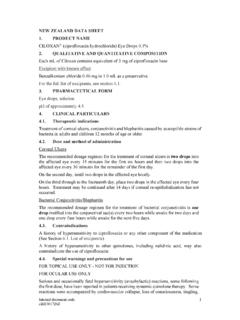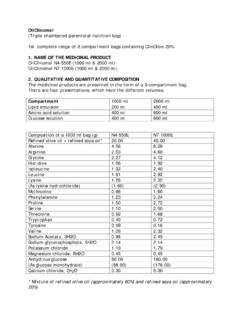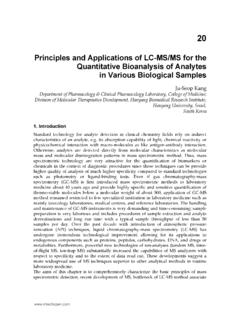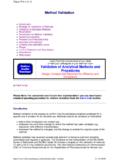Transcription of 2 QUALITATIVE AND QUANTITATIVE COMPOSITION
1 New Zealand Data Sheet February 2018 Rifadin rifadin-ccdsv10-dsv10-28feb18 Page 1 DATA SHEET 1 PRODUCT NAME Rifadin 150mg capsules Rifadin 300mg capsules Rifadin 600mg tablets Rifadin 100mg/5mL syrup Rifadin IV 600mg infusion 2 qualitative and quantitative composition Rifadin 150mg and 300mg capsules contain 150mg and 300mg of rifampicin per capsule respectively. Rifadin tablets* contain 600mg of rifampicin per tablet. Rifadin syrup contains 100mg of rifampicin per 5mL of syrup. Rifadin IV infusion contains 600mg rifampicin per vial. For the full list of excipients, see section *Not marketed in New Zealand 3 PHARMACEUTICAL FORM Capsules: 150 mg (blue/red, marked R-150) 300 mg (red, marked R-300) Tablets: 600 mg (cyclamen red) New Zealand Data Sheet February 2018 Rifadin rifadin-ccdsv10-dsv10-28feb18 Page 2 Syrup: 100 mg/5 mL (red, raspberry flavoured) IV infusion: 600 mg (spongy, fragile amorphous red powder), with 10 mL sterile water for injection solvent 4 CLINICAL PARTICULARS THERAPEUTIC INDICATIONS Tuberculosis Rifampicin is indicated in the treatment of all forms of tuberculosis, including fresh, advanced, chronic and drug resistant cases.
2 Rifampicin should be used in conjunction with at least one other antituberculosis medicine. Leprosy Rifampicin is indicated in the treatment of multibacillary and paucibacillary leprosy to effect a conversion of the infectious state to a non-infectious state. Rifampicin should be used in conjunction with at least one other anti-leprosy drug. Methicillin-resistant Staphylococcal infections (MRSA) Rifampicin can be used as an alternative to vancomycin in the treatment of MRSA. In such circumstances an appropriate companion antibiotic ( fusidic acid) should always be employed. Serious Staphylococcal Infections Rifampicin has been used for the treatment of both life-threatening and serious staphylococcal infections. In such circumstances an appropriate companion antibiotic should be employed (see Section ). Brucellosis Rifampicin may be used for the treatment of brucellosis. In such circumstances doxycycline should also be used. Meningococcal Carriers Rifampicin is indicated for the treatment of asymptomatic carriers of N.
3 Meningitidis to eliminate meningococci from the nasopharynx. (Rifampicin is not indicated for the treatment of meningococcal infection because of the possibility of the rapid emergence of resistant organisms). Haemophilus Influenzae Rifampicin is indicated for the treatment of asymptomatic carriers of H influenzae and as chemoprophylaxis of exposed children of 4 years of age or younger. Other infections Infections caused by rifampicin-sensitive microorganisms such as staphylococci, streptococci, N gonorrhoeae, Proteus sp., H. influenzae, E. coli and Legionella sp. To prevent emergence of New Zealand Data Sheet February 2018 Rifadin rifadin-ccdsv10-dsv10-28feb18 Page 3 resistant organisms, rifampicin should be given with another antibacterial agent to which the organism has been shown to be susceptible. DOSE AND METHOD OF ADMINISTRATION Rifampicin can be administered by the oral route or by intravenous infusion. Oral Administration Oral dosage should be taken on an empty stomach at least 30 minutes before a meal or 2 hours after a meal.
4 Tuberculosis In the treatment of tuberculosis, rifampicin should always be administered with at least one other antituberculosis medicine. The recommended single daily dose is 10 mg/kg, and is not to exceed 600 mg/day. Adult: Patients weighing less than 50 kg: 450 mg Patients weighing 50 kg or more: 600 mg Infants and Children: The recommended daily dose is 10-20 mg/kg body weight, and is not to exceed 600 mg/day. Under age of 1 month, the dosage is not established. Short Course Chemotherapy: In general, therapy for tuberculosis should be continued for 6 to 9 months or until at least 6 months have elapsed from conversion of specimen to negative culture. In patients who cannot be relied on for compliance, intermittent therapy with 600 mg/day two or three times/week under close supervision may be prescribed and substituted for the daily regimen after 1-2 months of an initial phase of daily therapy. The 6-Month Regimen ordinarily consists of an initial 2-month phase of rifampicin, isoniazid and pyrazinamide.
5 If resistant organisms are suspected or proven initially, a fourth medicine, streptomycin or ethambutol, should be added in the initial 2-month phase of the 6-month regimen. The 9-month Regimen ordinarily consists of rifampicin and isoniazid. If resistant organisms are suspected or proven initially, a third drug, ethambutol, should be added during the initial 2-3 months of the 9-month regimen. Long-Term Therapy: Patients with drug-resistant organisms may require longer treatment with other anti-tuberculous regimens. Leprosy To treat leprosy rifampicin should only be administered on one day each month. For patients weighing 50 kg or more: 10 mg/kg once a month (up to a maximum of 600 mg). For patients weighing less than 50 kg: 10 mg/kg once a month (up to a maximum of 450 mg). New Zealand Data Sheet February 2018 Rifadin rifadin-ccdsv10-dsv10-28feb18 Page 4 In the treatment of leprosy, rifampicin should always be used in conjunction with at least one other antileprosy drug.
6 Methicillin-resistant Staphylococcal Infections The recommended dose is 600-1200 mg daily in 2 to 4 divided doses. Rifampicin should always be administered with at least one other antibiotic. Serious Staphylococcal Infections The recommended dose is 600-1200 mg daily given every 12 hours. For sepsis and endocarditis, rifampicin should be administered with vancomycin ( grams intravenously every 8 hours). For severe (but not life-threatening), deep-seated staphylococcal infections, rifampicin should be administered with at least one other antibiotic. Brucellosis The recommended dose is 900 mg daily, taken each day at noon. Rifampicin should always be administered with doxycycline (200 mg daily, taken with the evening meal) for 45 days. Meningococcal Carriers Adults: It is recommended that 600 mg rifampicin be administered twice daily for 2 days (600 mg every 12 hours) or once daily for 4 consecutive days (600 mg daily). Infants and Children: Children 1 month of age or older: 10 mg/kg every 12 hours for 2 days or once daily for 4 consecutive days.
7 Children under 1 month of age: 5 mg/kg every 12 hours for 2 days or once daily for 4 consecutive days. Haemophilus Influenza Carriers For members of households exposed to H. influenza B disease and who are in contact with a child 4 years of age or younger, it is recommended that all members (including the child) receive rifampicin 20 mg/kg once daily (maximum daily dose 600 mg) for 4 days; neonates (less than 1 month) should receive 10 mg/kg daily for 4 days. Other Infections Daily dosage of 600-1200 mg given in 2 to 4 divided doses. Rifampicin should be given with another antibacterial agent with similar properties to prevent emergence of resistant strains. Intravenous Administration Rifampicin for infusion is indicated at the above doses when in the physician's judgment oral therapy is impractical. FOR INTRAVENOUS INFUSION ONLY. Must not be administered by intramuscular or subcutaneous route. New Zealand Data Sheet February 2018 Rifadin rifadin-ccdsv10-dsv10-28feb18 Page 5 For instructions on reconstitution or dilution of the medicine before administration, see section CONTRAINDICATION Jaundice.
8 History of hypersensitivity to any of the rifamycins. Rifadin use is contraindicated when given concurrently with the combination of saquinavir / ritonavir (see Section ). SPECIAL WARNINGS AND PRECAUTIONS FOR USE Liver Patients with impaired liver function should only be given rifampicin in cases of necessity and then with caution and under strict medical supervision. In these patients, careful monitoring of liver function, especially alanine aminotransferase (ALT) and aspartate aminotransferase (AST) should be carried out prior to therapy and then every two to four weeks during therapy. If signs of hepatocellular damage occur, rifampicin should be withdrawn. In some cases, hyperbilirubinaemia resulting from competition between rifampicin and bilirubin for excretory pathways of the liver at the cell level can occur in the early days of treatment. An isolated report showing a moderate rise in bilirubin and/or transaminase level is not in itself an indication for interrupting treatment; rather, the decision should be made after repeating the tests, noting trends in the levels and considering them in conjunction with the patient's clinical condition.
9 Immunological Reactions/Anaphylaxis Because of the possibility of immunological reactions including anaphylaxis (see Section ), occurring with intermittent therapy (less than 2 to 3 times per week) patients should be closely monitored. Patients should be cautioned against interruption of dosage regimens since these reactions may occur. Rifampicin Syrup Rifampicin Syrup contains sodium metabisulphite which may cause allergic type reactions including anaphylactic symptoms and life threatening or less severe asthmatic episodes in certain susceptible people. The overall prevalence of sulphite sensitivity in the general population is unknown and probably low. Sulphite sensitivity is seen more frequently in asthmatic than in non-asthmatic people. Drug Reaction with Eosinophilia and Systemic Symptoms (DRESS) syndrome Severe, systemic hypersensitivity reactions, including fatal cases, such as Drug Reaction with Eosinophilia and Systemic Symptoms (DRESS) syndrome have been observed during treatment New Zealand Data Sheet February 2018 Rifadin rifadin-ccdsv10-dsv10-28feb18 Page 6 with anti-tuberculosis therapy (see Section ).
10 It is important to note that early manifestations of hypersensitivity, such as fever, lymphadenopathy or biological abnormalities (including eosinophilia, liver abnormalities) may be present even though rash is not evident. If such signs or symptoms are present, the patient should be advised to consult their physician immediately. Rifampicin should be discontinued if an alternative etiology for the signs and symptoms cannot be established. Severe bullous reactions Cases of severe bullous skin reactions such as Stevens Johnson syndrome (SJS), toxic epidermal necrolysis (TEN), and acute generalized exanthematous pustulosis (AGEP) have been reported with rifampicin. If symptoms or signs of AGEP, SJS or TEN are present, rifampicin treatment must immediately be discontinued. Adults treated for tuberculosis with rifampicin should have baseline measurements of hepatic enzymes, bilirubin, serum creatinine, a complete blood count, and a platelet count (or estimate). Baseline tests are unnecessary in children unless a complicating condition is known or clinically suspected.
















